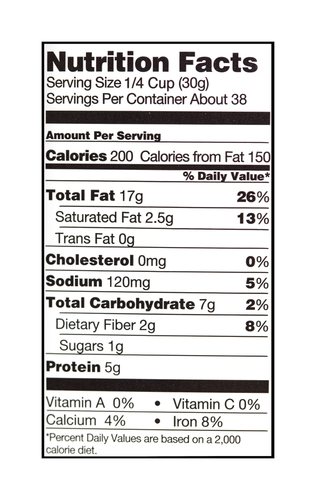Foods are labeled with a lot of information to help consumers make the best choices based on nutritional content — see example below.
But this information isn't always used appropriately — a consumer may not understand it or not be willing to take the time to figure out what's best for him or her. So various schemes have been proposed to make choices easier, but still accurate, as we've discussed before.
In the British Commonwealth, a system called the "Traffic Light" label has been used. A group of investigators in New Zealand wanted to ascertain whether this or another type of interpretive label would be more useful for consumers than the non-interpretive version above. Their study was published in the American Journal of Clinical Nutrition.

The traffic light (TLL) system puts a green (low), amber (medium) or red (high) symbol for total fat, saturated fat, sodium and sugar on a food package. The other interpretive label used was the Australian/New Zealand Health Star system (HS) in which foods are given anywhere from one half to 5 stars based on their nutritional content, with 5 stars being the best. Food choices based on these systems were compared to those made using a standard Nutrition Information Label, similar to that below. Participants in the study were all the main food shoppers in their households, were over 18 years old, and owned smartphones.
These folks were randomly assigned to one of 3 groups, each of which received information via an app on their phones: one group got the TLL information (n=472) about the foods they considered (scanned with their smartphones), another got information with the HS symbols (n=471), and the last group (control — n=470) only received the non-interpretive information on the standard nutrition facts label. The participants sent pictures and copies of their food purchase receipts to the investigators, which then allowed the researchers to determine if the different labels had an effect on food purchases. In the first week of the study, participants were required to use the scanning app for at least 15 items. Those that did so continued with the last four weeks of the study.
The food selections of each person were then "graded" based on the nutrient profiles using the Nutrient Profiling scoring Criterion of Australia and New Zealand. When all the participants were considered, there were no significant differences between the nutritional value of foods chosen with either the TL or the HS labels, compared to the control non-interpretive labels. However, when the investigators examined the subset of individuals who used food labels more than the average number of times (n = 423), they found that use of either interpretive label resulted in nutrition scores that were significantly better than those of people in the control group.
The investigators did suggest that use of a smartphone application may have been a barrier for some people in using label information — for example some individuals commented that they found using their phone while grocery shopping inconvenient. However, it seems that individuals who were already more interested and motivated to use available nutrition information found both types of interpretive label useful and made better food choices as a result. Obviously, the issue for those who want to improve the public's food choices (in a nutritional sense) is the problem of how to motivate those who are less interested to use the available information. This study has not really solved that issue.




